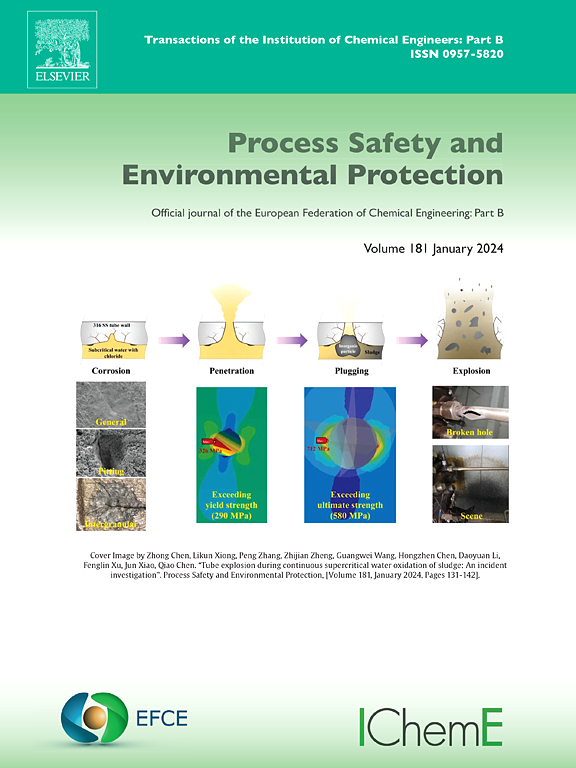Development of a new type of ammonia eliminator for swirl purifiers and study of its ammonia-eliminating mechanism
IF 7.8
2区 环境科学与生态学
Q1 ENGINEERING, CHEMICAL
引用次数: 0
Abstract
In this paper, we presented the construction of a test platform for ammonia elimination in swirl purifiers and the development of a new type of compound high-efficiency ammonia eliminator. A combined experimental and simulation approach has been shown to provide insights into the simultaneous purification of underground dust and ammonia. Firstly, the elimination effects of six reagent A-F in a short period of time were compared to establish performance evaluation system and reagent A and B exhibited the most effective performance. Secondly, reagents A and B were prepared in a ratio of 2:1, 3:1, and 3:2 to obtain reagents a, b, and c for comparative analysis. The test results demonstrated that reagents a, b, and c were mixed within 10, 5, and 10 min, respectively; the efficiency of ammonia elimination was 80 %, 83.3 %, and 76.7 %, respectively; the steady-state duration was 410, 500, and 320 min, respectively; and the continuous operation time was 830, 970, and 710 min, respectively, demonstrated that reagent b is the most effective. In addition, reagent b improved the odor of the discharged gas. Finally, molecular dynamics simulations were used to discuss the mechanism of simultaneous purification of ammonia and dust by composite reagent was discussed. The new type of ammonia eliminator was ultimately shown to employ in conjunction with swirl purifiers for efficient ammonia elimination.
新型旋流净化器除氨器的研制及其除氨机理研究
本文介绍了旋流净化器除氨试验平台的搭建和新型复合式高效除氨器的研制。一种实验和模拟相结合的方法已经被证明可以为同时净化地下粉尘和氨提供见解。首先比较6种试剂a - f在短时间内的消除效果,建立性能评价体系,其中试剂a和试剂B表现出最有效的性能。其次,将试剂A和试剂B按2:1、3:1、3:2的比例配制,得到试剂A、B、c进行对比分析。实验结果表明,试剂a、b、c分别在10、5、10min内混合完毕;氨氮去除效率分别为80%、83.3%和76.7%;稳态持续时间分别为410、500、320min;连续操作时间分别为830、970、710min,说明试剂b的效果最好。此外,试剂b改善了排出气体的气味。最后,通过分子动力学模拟探讨了复合试剂同时净化氨和粉尘的机理。新型氨消除器最终被证明与旋流净化器一起用于有效的氨消除。
本文章由计算机程序翻译,如有差异,请以英文原文为准。
求助全文
约1分钟内获得全文
求助全文
来源期刊

Process Safety and Environmental Protection
环境科学-工程:化工
CiteScore
11.40
自引率
15.40%
发文量
929
审稿时长
8.0 months
期刊介绍:
The Process Safety and Environmental Protection (PSEP) journal is a leading international publication that focuses on the publication of high-quality, original research papers in the field of engineering, specifically those related to the safety of industrial processes and environmental protection. The journal encourages submissions that present new developments in safety and environmental aspects, particularly those that show how research findings can be applied in process engineering design and practice.
PSEP is particularly interested in research that brings fresh perspectives to established engineering principles, identifies unsolved problems, or suggests directions for future research. The journal also values contributions that push the boundaries of traditional engineering and welcomes multidisciplinary papers.
PSEP's articles are abstracted and indexed by a range of databases and services, which helps to ensure that the journal's research is accessible and recognized in the academic and professional communities. These databases include ANTE, Chemical Abstracts, Chemical Hazards in Industry, Current Contents, Elsevier Engineering Information database, Pascal Francis, Web of Science, Scopus, Engineering Information Database EnCompass LIT (Elsevier), and INSPEC. This wide coverage facilitates the dissemination of the journal's content to a global audience interested in process safety and environmental engineering.
 求助内容:
求助内容: 应助结果提醒方式:
应助结果提醒方式:


